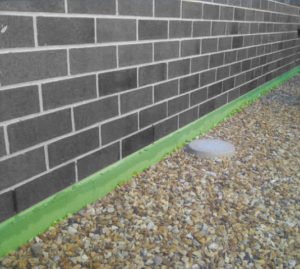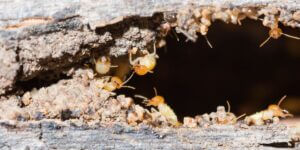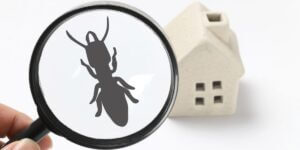Physical Termite Barrier

A physical barrier is installed in new and existing houses to prevent undetected entry. Some common misconceptions are that a “physical termite barrier” is installed and people presume the house is ultimately protected and thus termites will never enter the property and homeowners become relaxed on not getting annual inspections.
As a homeowner, you need to understand what termite management is about these days. Basically, in a nutshell, The changes in the way houses were built occurred in the late 90s early 2000’s when we did away with all the toxic under slab treatments.
This new change requires now all houses to be built so that termites can not gain “undetected” entry. (This was in response to the fact organochloride chemicals were no good for the environment and us, and also chemical expires leaving the house unprotected and termites can gain “undetected” entry).
The word “undetected” is very important in understanding the concept. The physical termite barriers installed to new houses are designed to be long-lasting and to stop “undetected termite entry”. As a homeowner, you are required to maintain annual or six monthly termite inspections due to the fact the physical barrier will only stop “undetected entry” (It doesn’t stop them exposing themselves).
Termites can and do cross this physical barrier. An annual inspection also ensures that the product installed is working adequately. If the product fails due to factors such as an installation fault or the homeowner has affected how the product works, You may not in most cases be entitled to any warranty. What is a visual termite inspection zone? It is the area around the property generally below the weep holes or ant capping that we can inspect to identify termite activity.
Chemical Treated Zone.

“Termite barriers” and chemical treated zones are good in the sense that they prevent termites from entering the area where the soil has been treated with the chemical. The issue with chemical treated zones is the fact that if it has been applied after construction it is injected below the slab surface.
It is impossible to fully know where this chemical goes. In saying that, it is essential to maintain annual inspections on all properties that have a termite management system installed.
These systems are designed to lower the risk. Some chemical treated zones use delivery methods such as reticulation hoses buried below the soil. It is important to know when these are due to be replenished.
Termite Baiting Systems.
There are many types of baiting systems available. However, they all work on the same principle. The baiting stations attract termites before they enter your home. Thus, Termites are then fed bait that contains an active constituent to eliminate the colony.
The effectiveness of baiting stations relies on maintenance. Bait stations are placed every 3-4 meters around the perimeter of the structure.
The bait system is inspected every 6-8 weeks with older systems or 4 times a year with the new Sentricon Always Active System. Termites are all part of a large colony and are constantly connected as one.
Termites will feed each other and the queen. Once the termites have ingested the poison from the bait stations it is transferred throughout the colony and results in colony collapse. Baiting is a great way of controlling subterranean termites as their nest is often hard to or almost impossible to locate as it is hidden in a tree or beneath the soil and can wreak havoc for years.
Termite inspections

Termite Inspections are a process of elimination. Termite inspections annually should be an essential part of home maintenance in Australia. Termites are a common problem affecting homeowners, and the current statistic is that termites affect 1 in 4 Northern N.S.W homes. A major financial loss is caused by termite damage throughout Australia every year. These losses are mainly due to property owners forgetting to have there an annual check, lack of property maintenance or building faults. As a homeowner, you can reduce this risk by having a thorough inspection carried out annually.
A Termite Inspection must be carried out to the current Australian Standard AS 3660.2.17. Our inspectors are licensed and experienced and use the latest technology including nondestructive and noninvasive thermal and radar equipment. Once the inspection is complete we issue you with a photographic report with also recommendations on how to reduce the risk of termite attack and also a termite management plan if required. What does a Termite Inspection involve?
The technician will inspect all areas of your property, including roof void, subfloor, internals and externals of the structure using a timber sounding device with a trained ear to detect any abnormalities in timbers that may be a result of termite activity. Secondly, A moisture meter is used to detect any areas that may contain termite infestation (If termites are active behind wall cavities, a high moisture reading is obtained) or areas that may be conducive to termite activity.
Thirdly, The use of specialist equipment, including the Termatrac T3i Radar and Thermal is used to differentiate between termites or just high moisture. Finally, The inspector will compile a digital and photographic termite inspection report and termite management plan if required that will also outline areas of concern, recommendations, and tips on how to reduce the risk of termite attack.
The report is emailed the same day in PDF format. If an infestation has been identified a termite inspection is essential as it enables us to map out a proposal and termite management plan to be put forward with the best method of treatment. Different situations require different treatments, In some situations, baiting may be best as opposed to chemical treatment. Our technician will provide the right advice on site. Feel free to obtain 3 quotes in this situation.
What’s Included in a Termite Inspection? ▶ Termatrac T3i Termite Radar ▶ Free Thermal Imaging ▶ Sounding of timbers ▶ Moisture detection ▶ Also detection for mould a termites food source ▶ Timber decay ▶ Identification of areas conducive to termite attack ▶ Also, Digital photographic report produced same day with a list of recommendations to reduce the risk of termite attack.
Termite inspections on an annual basis are designed to not only identify live termites however issues that may attract termites. The homeowner may not be aware of high moisture, Building faults and conducive conditions.
From experience, it only takes a slight leak in the shower wall backing onto a garden bed on an old infill slab with a pine frame, and it will be a matter of time till termites have found a way in. Identifying and rectifying high-risk areas on an annual basis will, in fact, reduce the risk of major damage caused by termites.





